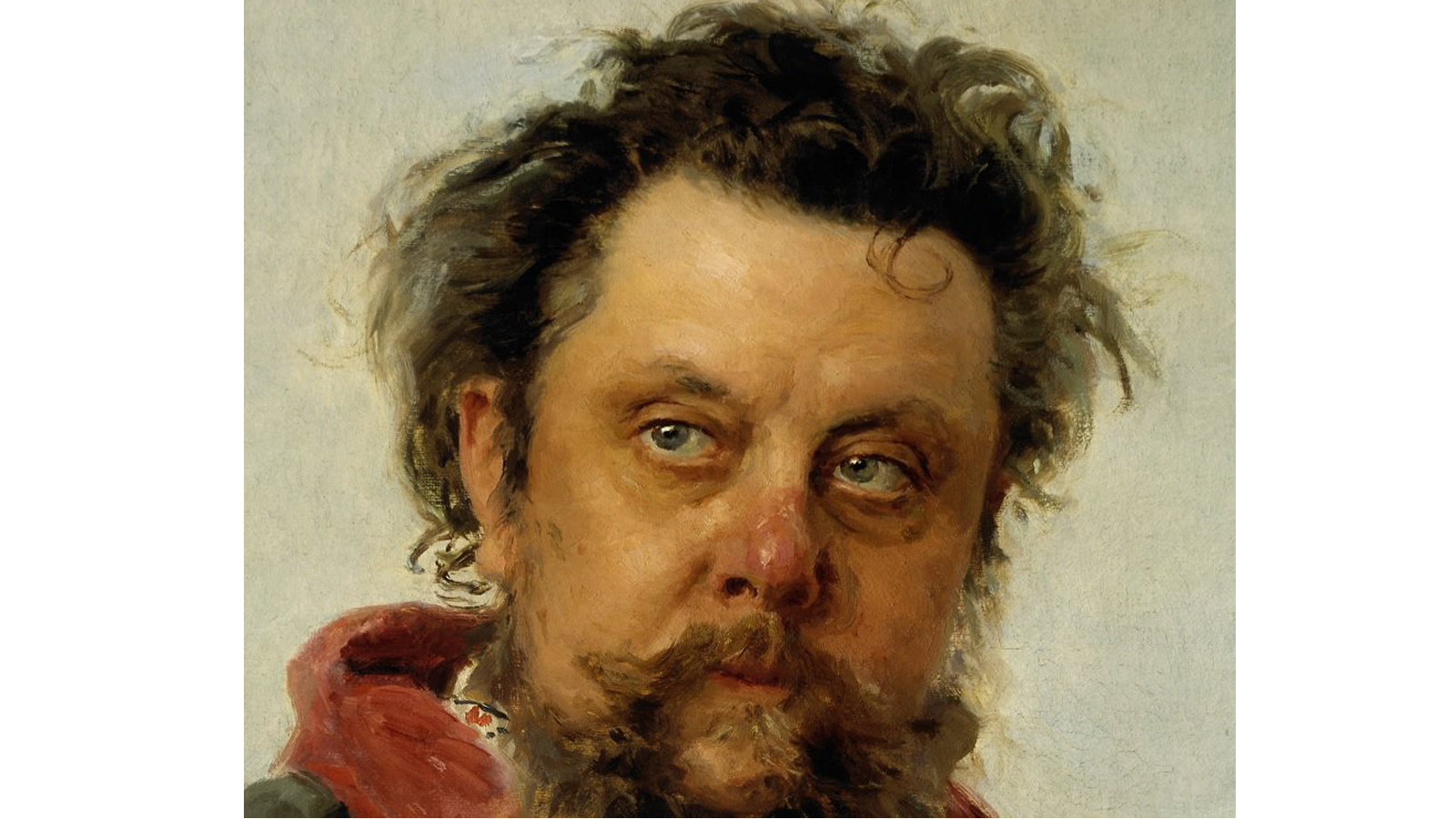
No. 15
Mussorgsky: Pictures at an Exhibition

Modest Mussorgsky was the wildest of the five Russian composers known as “the Mighty Handful”. Like Balakirev, Cui, Borodin and Rimsky Korsakov, Mussorgsky devoted his energies to creating orchestral pieces that “sounded” Russian, operas that were based on Russian history or Russian folklore, and chamber music that avoided established genres like sonatas and quartets. Born to a very old aristocratic family, he eventually became politically radical. Mussorgsky was in favor of the emancipation of the serfs, which when it did occur in 1861, almost impoverished his family. His father had intended him for a military career. As a cadet at the elite military academy in St. Petersburg, Mussorgsky won a reputation both as an outstanding pianist and as a party animal. His brilliant piano playing soon led him to a group of companions that included Mily Balakirev, who undertook to educate Mussorgsky in musical composition. Mussorgsky’s partying led to lifelong alcoholism with its attendant depressions and manic episodes.
Mussorgsky never married, and he spent his short life in a series of mid-level civil service jobs while he struggled to write music. He never had a fixed abode, living with one friend or another for long periods of time. Aesthetically, Mussorgsky moved beyond his contemporaries by rejecting both formal musical conventions and espousing a need for music to reflect “real life”. Given his alcoholism and his circumstances his world view darkened and that darkness is often to be found in his music. After Mussorgsky’s death, Rimsky-Korsakov and others edited and revised much of Mussorgsky’s music, making it “presentable.” And so they rescued it for future generations. However, late in the 20th century, there has been a movement to resuscitate Mussorgsky’s original versions of his masterworks.
Pictures at an Exhibition is a classic case of how, once written, a piece of music lives a life of its own. Mussorgsky, unlike the other composers of “The Five”, was a virtuoso pianist. But he had no desire to make a living as such. His pianism was reserved for domestic or fraternal music making. Having rejected the idea of writing sonatas and concertos, his writing for the piano was confined to songs (at which he was Tchaikovsky’s only rival) and character pieces. Pictures at an Exhibition provided him with a programmatic device of “Russian” provenance to construct a large scale piano work. The “Pictures” that inspired the piece were the work of architect and artist Victor Hartmann who became a close friend of Mussorgsky’s. Hartmann died suddenly. A memorial exhibition of Hartmann’s drawings was the direct inspiration for the piano collection.
As to the reception of the piece, a friend of Mussorgky’s wrote after his death: “There was no end to the enthusiasm shown by his devotees; but many of Mussorgsky's friends, on the other hand, and especially the comrade composers, were seriously puzzled and, listening to the 'novelty,' shook their heads in bewilderment. Naturally, Mussorgsky noticed their bewilderment and seemed to feel that he ‘had gone too far.’ He set the illustrations aside without even trying to publish them.” Pictures waited for Rimsky Korsakov to revise it for publication after Mussorgsky’s death. Almost immediately parts of it were orchestrated, and the Pictures have called to orchestrators ever since.
It was Serge Koussevitzky who locked up the market on orchestrations. Setting himself up in Paris as both a conductor and a music publisher, Koussevitzky made canny use of his wife’s fortune. In 1922, after making arrangements with the publisher of the Rimsky Korsakov’s revisions of Pictures, he commissioned Maurice Ravel to orchestrate the piano work. Ravel, known for his brilliant orchestrations of his own piano works, took to Pictures. Almost immediately Ravel’s orchestration was hailed as a masterwork on its own. And speaking of ownership, the new Pictures at an Exhibition was owned by Serge Koussevitzky, who leveraged his way onto a number of podiums because, being the owner, he could decide who could play his Pictures and who couldn’t. Once established, however, as the Music Director of the Boston Symphony, Koussevitzky allowed anyone to use Ravel’s orchestration as long as they paid him to do it.
Top 40 Countdown
A few years ago the listeners to WNED Classical told us what they thought a TOP 40 list of Classical pieces should be. Six hundred and twenty-two different pieces were put forward, and over nine hundred listeners participated. The result, The WNED Classical Top 40, was both startling and comforting. There were a number of surprises, Stravinsky and Copland made the list; Mendelssohn and Schumann did not! It was comforting to know that the two most popular composers were Beethoven and J.S. Bach. The biggest surprise of all was the piece that crowned the list as No. 1.